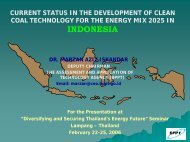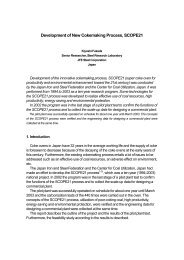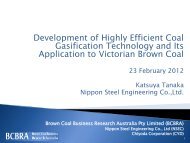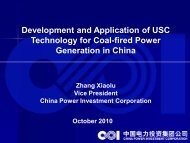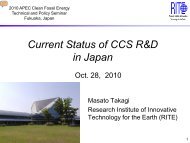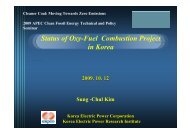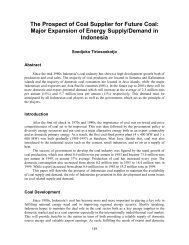Defining CCS Ready: An Approach to An International Definition
Defining CCS Ready: An Approach to An International Definition
Defining CCS Ready: An Approach to An International Definition
- No tags were found...
Create successful ePaper yourself
Turn your PDF publications into a flip-book with our unique Google optimized e-Paper software.
Appendix C: Policy Considerations and Assessments of <strong>CCS</strong> <strong>Ready</strong> Economics• Reference Plant (Not <strong>CCS</strong> <strong>Ready</strong>) – A business-as-usual (“BAU”) plant with noanticipation of future carbon capture controls. The plant is a nominal 600 MWsupercritical PC. Although no specific space and tie-ins are provided in this plant, aretrofit is assumed <strong>to</strong> be reasonably possible.• Option 1 (Throttle valve case) – Along with the minimum essential capture readysteps, such as ensuring enough land and building space, the only major expense for thisoption is the front-end engineering design (FEED) work <strong>to</strong> plan for retrofitting an aminebasedcarbon capture system, with a provision for incorporation of a throttle valve,ducting, and extraction steam piping <strong>to</strong> the amine reboiler.• Option 2 (Clutch case) – The second option has a FEED and the incorporation of aclutch between the two low-pressure steam turbine stages. With 50% steam extractionfor the amine reboiler, declutching the second low pressure steam turbine stage fromoperation would improve heat rate performance.• Option 3 (Oversize case) – Option 3 increases the size of the steam furnace suchthat there is no loss in electric output capacity (MWe) compared with after a captureretrofit. All downstream systems are upsized as well <strong>to</strong> accommodate both the increasein steam flow as well as flue gas. Before retrofitting, the boiler is assumed <strong>to</strong> operate atpartial load with no heat rate penalty.To account for uncertainties in future <strong>CCS</strong> technologies, two <strong>CCS</strong> retrofit options arerepresented in addition <strong>to</strong> a “no <strong>CCS</strong> retrofit” option. The “current” capture technology isan amine solvent and the “advanced” case is an unspecified solvent process that requiresone-half of the energy used for current amine solvent regeneration.C.4.2 Decision Criteria for <strong>CCS</strong> RetrofitIn the Monte Carlo analysis the option <strong>to</strong> retrofit the plants <strong>to</strong> current <strong>CCS</strong> technology(and, if available, the advanced <strong>CCS</strong> technology) is evaluated in each operating year based onthe principle of profit maximization by the plant developer. If the discounted net presentvalue of the plant can be increased by the <strong>CCS</strong> retrofit, then retrofit is assumed <strong>to</strong> takeplace that year. Because the plants are modelled as having a maximum life of 41 years,retrofit costs must be recovered between the retrofit year through the year 2055. Thedecision between current and advanced <strong>CCS</strong> technologies is assumed <strong>to</strong> be made“myopically” based only on whether or not the advanced technology exists in the retrofityear. In other words, the power plant owner does not know the advanced <strong>CCS</strong> technologyis coming until after it arrives.A key determinant of when the retrofit will take place is the assumed CO 2 allowance price.Sufficient economic incentive for retrofit may be provided as the allowance priceapproaches or exceeds the per-unit-abated <strong>to</strong>tal cost (i.e. $/tCO 2 e) of the <strong>CCS</strong> retrofitincluding all money-forward capital and operating costs. This per-unit-abated economicindica<strong>to</strong>r is “approximate” because the process of retrofit likely will increase plant dispatch(capacity utilization) and may increase operating life by dropping the variable operating cos<strong>to</strong>f the power plant (chiefly because the CO 2 allowance cost then will be paid for 90 percentfewer CO 2 emissions) 154 Because the hours dispatched and operating life of the plant mayincrease after <strong>CCS</strong> retrofit, the economic measure of $/tCO 2 e abated versus allowance154 If the Monte Carlo example were done for a jurisdiction that has severe electricity supply shortages, then the retrofit ofthe plant <strong>to</strong> <strong>CCS</strong> might not be modeled as increasing capacity utilization.23 February 2010 108



